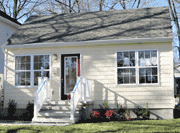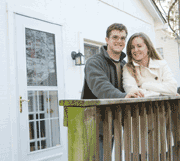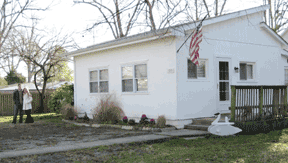|
||||||||
A Home of Our Own
|
 |
|
The first home we toured, we were convinced we had discovered our perfect starter home. In the cold light of reality, with the exception of the view, the house had less to offer us. |
After five minutes in this house, I had determined where to put a cozy, over-stuffed armchair. If I positioned myself in the front right corner of the living room, I could see the dusky blue of the Bay. I strolled into the tiny master bedroom. Uncertain if I could fit both a dresser and a bed in the room, I opened the closet door. Maybe I could fit a third of my wardrobe. But what a view. Adorable, well-kept cottages filled the neighborhood. The price was a little more than we wanted to pay, but the house was perfect.
It was the first home we toured, and we were convinced we had discovered our perfect starter home. We made an offer, albeit below the asking price. When our offer was rejected, we contemplated an increase.
That’s when Brad’s pragmatic side came out. I loved the water-view house, but the home just wasn’t worth the price. Waking up to sun-sparkled ripples on the Bay would be glorious, but was it necessary? In the cold light of reality, with the exception of the view, the house had little to offer. It was small, had minimal storage and the layout didn’t flow well. We didn’t make a counter offer. I knew we had made a wise decision, but that didn’t prevent me from feeling we would never own a home.
Home Hunting
When we started searching again, extremely high prices disheartened us. The monthly mortgage payment for a house valued at $400,000 was beyond my imagining. Brad and I were in our first few years in the work force. How would we ever afford a house?
Here I was, a life-long citizen of Anne Arundel County, but when it finally came time for me to buy my piece of the American dream, the only house I could afford had a matchbox kitchen and stinky carpet.
From 1990 to 2000, the population of Anne Arundel County increased by 14.6 percent. Since 2000, over 20,000 more people moved into the county. In Calvert, the increase has been even larger: 45 percent in the decade from 1990 to 2000. In the past five years, an additional 13,362 people moved to Calvert County.
Attracted by suburban and rural settings, newcomers are willing to endure a long commute to enjoy Chesapeake life. As more people move here, the supply of housing diminishes, causing home prices to increase. Homes our parents purchased for less than $200,000 have doubled, even tripled in value.
But since July, the buyers’ market is looking up. The national housing market has cooled, a fact buyers see reflected in the number of houses to choose from.
“First-time buyers can buy more house now,” said Rod Irving, an agent with Long & Foster Realtors in Annapolis. “There’s more to look at now as opposed to last year. In the last six months, inventory of homes for sale has tripled.”
Eileen Kessler, president of the Maryland Realtors Association, is an agent with more than 20 years of experience. “Prices change monthly,” she said. “The last couple years have changed the price structure.”
Desperate for a Home
It looked as if remodeling had started, then been abandoned. The remodeler had, one day, carefully placed his paintbrush on the top of a dresser and left. Paintbrushes, hammers and screwdrivers collected dust throughout the house. Even more conspicuous than the oddly placed tools was the absence of a kitchen. The only evidence of a stove was the entrance pipe for the gas. I scanned a curled brown list of rules for renters, posted on the wall and dated 1986.
After we’d toured this house, the others didn’t look so bad.
As we searched, we saw positives in even the most dismal homes. In the house without a kitchen Brad remarked, “at least we could pick out all the new appliances.” The stinky carpet house had plenty of room for an addition. We viewed any house with a roof and functional plumbing as a potential home.
 |
|
The house that became known as the stinky carpet house – here remodeled – was a low point in our home search. It discouraged me for days, but it taught me an important lesson: The key to buying your first home is combining patience with perseverance. |
A Homely House
From the outside, the tiny house in Shady Side looked ordinary. Stained carpet covered the first room we entered, but the ceilings were high and light flooded in from a skylight. It got worse. Additional rooms connected to the main room haphazardly, as if the builders started adding on rooms before they stopped to consider how and where the rooms would connect.
An unexplained shift in floor height tripped me in the dining room. The kitchen was small, as in most beach cottages. However, unlike most homes, the kitchen ceiling of this one sloped down at an alarming angle. I anticipated a crash at any moment.
“Well, at least there’s a backyard, so when the kitchen ceiling comes down we can extend the new kitchen,” Brad said. “It’s a really nice backyard.” He and I contemplated a new kitchen with a garbage disposal and nice cabinets.
Gary Coombe, our real estate agent, could take our talk no longer. “This house is horrible,” he said. “I would never let you buy it. I could see spending the money on a new kitchen if the house had good bones. But it doesn’t.”
Brad and I were fortunate that our agent was experienced in home construction. If he hadn’t spoken up, I could’ve been eating breakfast under a backyard tree.
I learned later about the theory of reduced expectations.
“You’re first home won’t always have everything you want,” explained Kessler. “You’ve got to have realistic expectations.”
At this stage in our house hunt, our realistic expectation seemed to be signing another lease.
Doing Our Homework
 |
|
The remodeler had, one day, carefully placed his paintbrush on the top of a dresser and left. Paintbrushes, hammers and screwdrivers collected dust throughout the house. Even more conspicuous than the oddly placed tools was the absence of a kitchen. |
Our agent emailed new listings as soon as they hit the market. Electronic resources simplified our hunt. Instead of driving to each house, I first toured virtually. Almost every listing includes interior and exterior photos. I couldn’t smell the carpet virtually, but we could eliminate a home where the kitchen was too small or nonexistent.
As we scanned rooms, I also learned that there was more to many a home than its vinyl siding. On first impression, I might judge a house to be a generic rancher. Without taking the time to look at interior photos, I would never know that the owner recently installed hardwood floors and renovated the kitchen. Seeing a room with potential enticed us to tour houses that we would have missed.
In addition to showing us properties we otherwise wouldn’t see, our agent helped us find out what we could realistically afford.
“The first step with first-home buyers,” says Long and Foster agent Rod Irving, “is to hook them up with a lender. I need to know how much house they can afford.” So did we. After determining how much we could afford, our agent knew where to look.
Brad and I knew we couldn’t afford a single-family home or townhouse in Annapolis, where a typical townhouse is in the $400,000 range. But Brad and I found that the prices in Southern Anne Arundel County were much more our speed, so we focused our search there.
The amount you pre-qualify for helps you focus your home search on specific areas or neighborhoods. Ultimately, though, “people need to live where they want to live,” said Eileen Kessler. That’s why Kessler tours homes in various price ranges with first-time homebuyers, giving them an idea of what type of home they can actually purchase. “You may have to make compromises, and if you’re really frustrated you may just have to wait,” Kessler explained.
After leaving the sloped-ceiling home feeling disappointed and discouraged, Brad and I sat down to wait.
A Home of Our Own
I clicked on the attachment to the email of new home listings. Several condos and a few homes flew by as I scanned, nothing particularly catching my attention. The small, white, unassuming house was no different.
But I was used to looking beyond the cover, so I clicked on the camera symbol directing me to interior pictures. Inside, the small, unassuming house was warm and welcoming. New Brazilian cherry hardwood floors sparkled throughout. Thick molding lined both ceiling and floor. Instead of one lot, this home boasted a quarter of an acre. Amazed by such amenities, I insisted that Brad see the house as soon as possible.
Still in Richmond and with work the next day, I couldn’t drive up that night to tour the house that now intrigued me. So Brad went alone. He called me afterward, equally amazed. That night, before I’d ever seen it, we made on offer.
After months of disappointment and uncertainty, on July 14 we signed on our home.
 |
|
The search over at last, the new owners are making their first house into a home. |
Home at Last
Buying a first house is a bumpy journey. Along the way, I learned that we say starter home for a reason. Our first home is riddled with imperfections. In the bathroom that would become mine, I witnessed the sponge-painter’s homage to Van Gogh’s Starry Night. Within the first week of signing the papers, we painted the bathroom a buttery yellow. There’s not nearly enough closet space for clothes or shoes. The kitchen is smaller than my bathroom at my parents’ house. Each room is a work in progress. The house isn’t perfect. But it’s ours. Now we’re making it our home.


